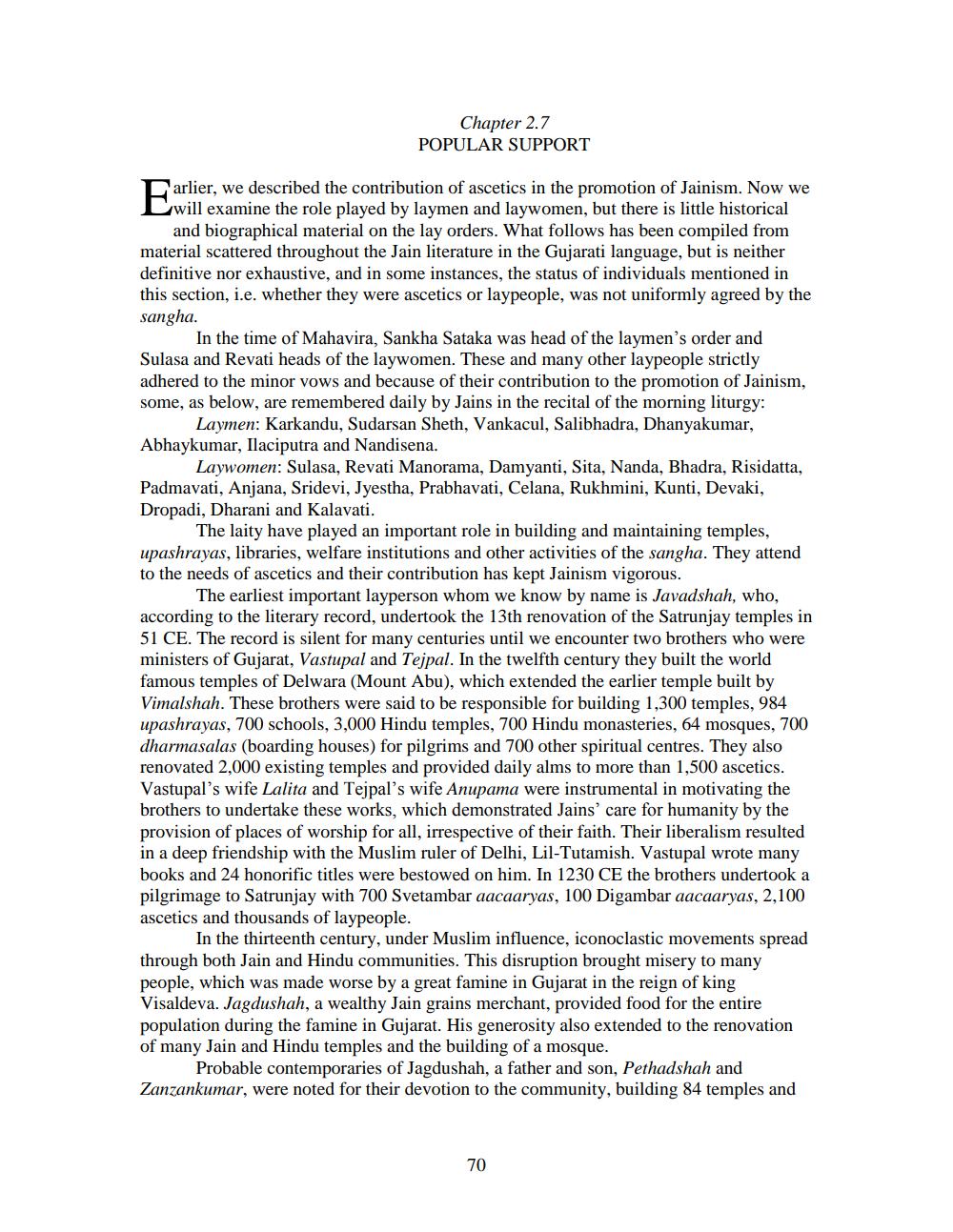________________
Chapter 2.7 POPULAR SUPPORT
arlier, we described the contribution of ascetics in the promotion of Jainism. Now we
and is historical
and biographical material on the lay orders. What follows has been compiled from material scattered throughout the Jain literature in the Gujarati language, but is neither definitive nor exhaustive, and in some instances, the status of individuals mentioned in this section, i.e. whether they were ascetics or laypeople, was not uniformly agreed by the sangha.
In the time of Mahavira, Sankha Sataka was head of the laymen's order and Sulasa and Revati heads of the laywomen. These and many other laypeople strictly adhered to the minor vows and because of their contribution to the promotion of Jainism, some, as below, are remembered daily by Jains in the recital of the morning liturgy: Laymen: Karkandu, Sudarsan Sheth, Vankacul, Salibhadra, Dhanyakumar, Abhaykumar, Ilaciputra and Nandisena.
Laywomen: Sulasa, Revati Manorama, Damyanti, Sita, Nanda, Bhadra, Risidatta, Padmavati, Anjana, Sridevi, Jyestha, Prabhavati, Celana, Rukhmini, Kunti, Devaki, Dropadi, Dharani and Kalavati.
The laity have played an important role in building and maintaining temples, upashrayas, libraries, welfare institutions and other activities of the sangha. They attend to the needs of ascetics and their contribution has kept Jainism vigorous.
The earliest important layperson whom we know by name is Javadshah, who, according to the literary record, undertook the 13th renovation of the Satrunjay temples in 51 CE. The record is silent for many centuries until we encounter two brothers who were ministers of Gujarat, Vastupal and Tejpal. In the twelfth century they built the world famous temples of Delwara (Mount Abu), which extended the earlier temple built by Vimalshah. These brothers were said to be responsible for building 1,300 temples, 984 upashrayas, 700 schools, 3,000 Hindu temples, 700 Hindu monasteries, 64 mosques, 700 dharmasalas (boarding houses) for pilgrims and 700 other spiritual centres. They also renovated 2,000 existing temples and provided daily alms to more than 1,500 ascetics. Vastupal's wife Lalita and Tejpal's wife Anupama were instrumental in motivating the brothers to undertake these works, which demonstrated Jains' care for humanity by the provision of places of worship for all, irrespective of their faith. Their liberalism resulted in a deep friendship with the Muslim ruler of Delhi, Lil-Tutamish. Vastupal wrote many books and 24 honorific titles were bestowed on him. In 1230 CE the brothers undertook a pilgrimage to Satrunjay with 700 Svetambar aacaaryas, 100 Digambar aacaaryas, 2,100 ascetics and thousands of laypeople.
In the thirteenth century, under Muslim influence, iconoclastic movements spread through both Jain and Hindu communities. This disruption brought misery to many people, which was made worse by a great famine in Gujarat in the reign of king Visaldeva. Jagdushah, a wealthy Jain grains merchant, provided food for the entire population during the famine in Gujarat. His generosity also extended to the renovation of many Jain and Hindu temples and the building of a mosque.
Probable contemporaries of Jagdushah, a father and son, Pethadshah and Zanzankumar, were noted for their devotion to the community, building 84 temples and
70




